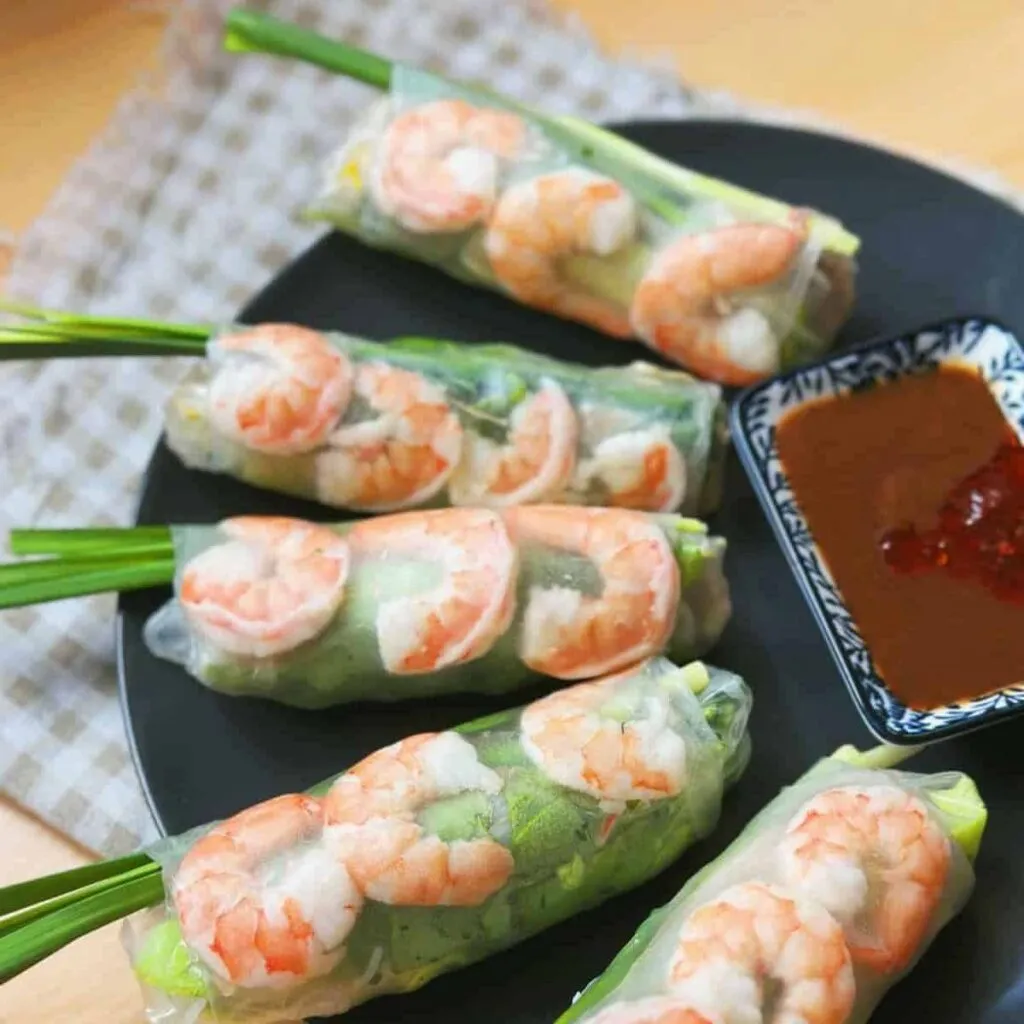Canh Bún is a humble, rustic Vietnamese noodle soup that may not be widely known but is deeply cherished. It holds a special place in my heart, reminding me of my beloved Saigon.
I cooked up a batch of Canh Bún this week and decided to pen down the recipe to spread the love for this comforting dish.
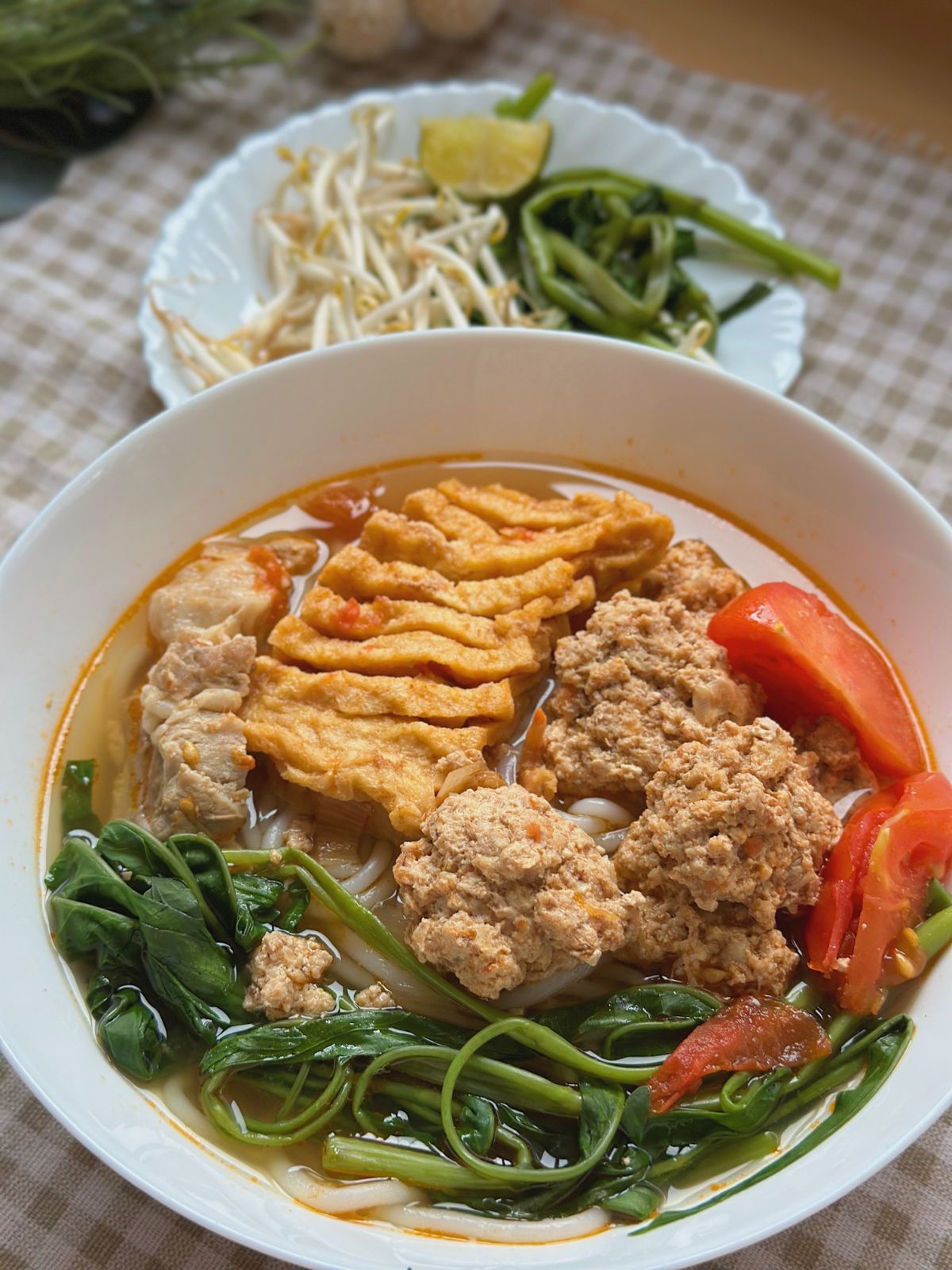
Table of Contents
What is Canh Bún?
Canh Bún is a Northern Vietnamese rice noodle soup with the broth made from rice paddy crabs.
Just like Phở, Bún Mọc (rice noodle soup with meatballs), Bánh Cuốn (steamed rice rolls), and Bún Thang (rice noodle soup with chicken), Northern Catholics introduced this dish to the South after the 1954 exodus.
Of course, there are quite significant differences between the Northern and Southern versions.

In the South, Canh Bún is quite similar to Bún Riêu. Typically, food stalls in Saigon will sell Canh Bún, Bún Riêu, and Bún Ốc (snail noodle soup) together since they share the same broth base.
Canh Bún and Bún Riêu also share similar toppings. However, Canh Bún features thick, round rice noodles like those in Bún Bò Huế, along with blanched water spinach. In contrast, Bún Riêu uses thin round rice noodles and is served with shredded water spinach and banana blossoms.
Moreover, Canh Bún will have a slightly tangier broth than Bún Riêu, which is why it could be seasoned with some tamarind sauce at the end.
In Northern Vietnam, Canh Bún and Bún Riêu are two separate dishes. In the North, Canh Bún is served with a modest amount of broth, quite similar to Mì Quảng. It also uses thick round rice noodles but is accompanied with blanched water mimosa (rau nhút) instead of blanched water spinach.
Ingredients
You can find the ingredients at Asian markets. For precise measurements, refer to the recipe card at the end of this post.
For the crab paste (Riêu Cua)

- Canned crab paste (or Bún Riêu seasoning): Riêu cua is the essence of Canh Bún. In Vietnam, we traditionally use rice paddy crabs to make the crab paste but today I will make “Riêu” from canned crab paste. Here I used two brands of crab paste, but you can opt for just one.
- Sometimes you could find frozen minced crab at Asian markets. Use it to make riêu cua, your riêu cua will taste way better.


- Ground pork, eggs, dried shrimps, and crab meat: Crab meat is just optional. I’m incorporating some since I still have some leftovers after making Chả Trứng Hấp (steamed egg meatloaf) for Cơm Tấm (broken rice platter).
For the soup base

To prepare the soup base, we will need:
- Pork ribs: you could use pork bones also.
- Dried shrimps: In the South, dried shrimps are a popular ingredient for cooking broth, not only in Canh Bún but also in Hủ Tiếu (tapioca noodle soup), Bánh Canh (thick noodle soup), and Súp Nui (macaroni soup).
- Onion: Adding onion lends a slightly sweet and umami flavor to the broth.
- Tomato: it also contributes a sweet and umami flavor to the broth.
- Paprika powder: the paprika oil will give a vibrant red color to the soup. In Vietnam, we use annatto oil, but I have found that paprika oil is a perfect substitute.
- Lemongrass: A small stalk of lemongrass imparts a delightful flavor to the broth. This tip was passed down to me by my close friend’s mother but it’s optional.
- Seasonings: fish sauce, rock sugar (or granulated sugar), chicken powder and some mắm tôm (fermented shrimp paste).
- Mắm tôm is a traditional seasoning for Canh Bún, but I prefer to serve it on the side for those who enjoy it. While I love mắm tôm in Bún Đậu Mắm Tôm , I know it’s not for everyone.
Other Toppings
Toppings for Canh Bún closely resemble those in Bún Riêu. Water spinach (Ong Choy) and fried tofu are recommended for Canh Bún, while other toppings are optional.
- Pork blood (huyết)
- Pork hocks
- Rice paddy snails
- Chả lụa (Vietnamese pork rolls)
Accompaniments
- Rice noodles: use the thick round rice noodles for Bún Bò Huế
- Mắm Tôm (fermented shrimp paste): a staple condiment in Northern Vietnamese cuisine, often found in Chả Cá Lã Vọng (turmeric fish with dill) and Bún Đậu Mắm Tôm (rice noodles with fried tofu and fermented shrimp paste). It is distinct from Mắm Ruốc, another variety of shrimp paste.

- Veggies & herbs: you could serve Canh Bún with mung bean sprouts and some Vietnamese herbs like Vietnamese Balm (kinh giới) and Perilla Leaves (tía tô).
- Tamarind sauce: Canh Bún broth often carries a gentle tanginess, which you may enhance with a touch of tamarind sauce before serving, though this step is optional.
Instructions
Make the broth
- Rinse the dried shrimps.
- Parboil the pork ribs with some salt, then wash and rinse them thoroughly.
- Return the pork ribs to the pot with water, onion, lemongrass, dried shrimps, salt and rock sugar. Simmer over medium-low heat for one hour, ensuring to skim off any scum that rises to the surface.


- Slice the shallots and cut the tomatoes into wedges.
- In a pan, heat some cooking oil and 1 tbsp paprika powder over medium-low heat for about 3 minutes to infuse the color from the paprika powder into the oil. Add the shallots and sauté until fragrant.
- Add 2/3 of the tomatoes. Stir-fry the tomatoes with some fish sauce until they are soft and fully cooked.


- Transfer all the tomatoes to the broth, making sure to scrape all the tomato sauce from the pan—it’s the GOLDEN LIQUID.
- Add the fried tofu to the broth.

Make the crab paste
- Wash the dried shrimps and soak them in water until they become plump and soft. Drain the shrimps and add the soaking liquid to the broth.
- Blend the shrimps in the food processor until they achieve a cotton floss-like texture.
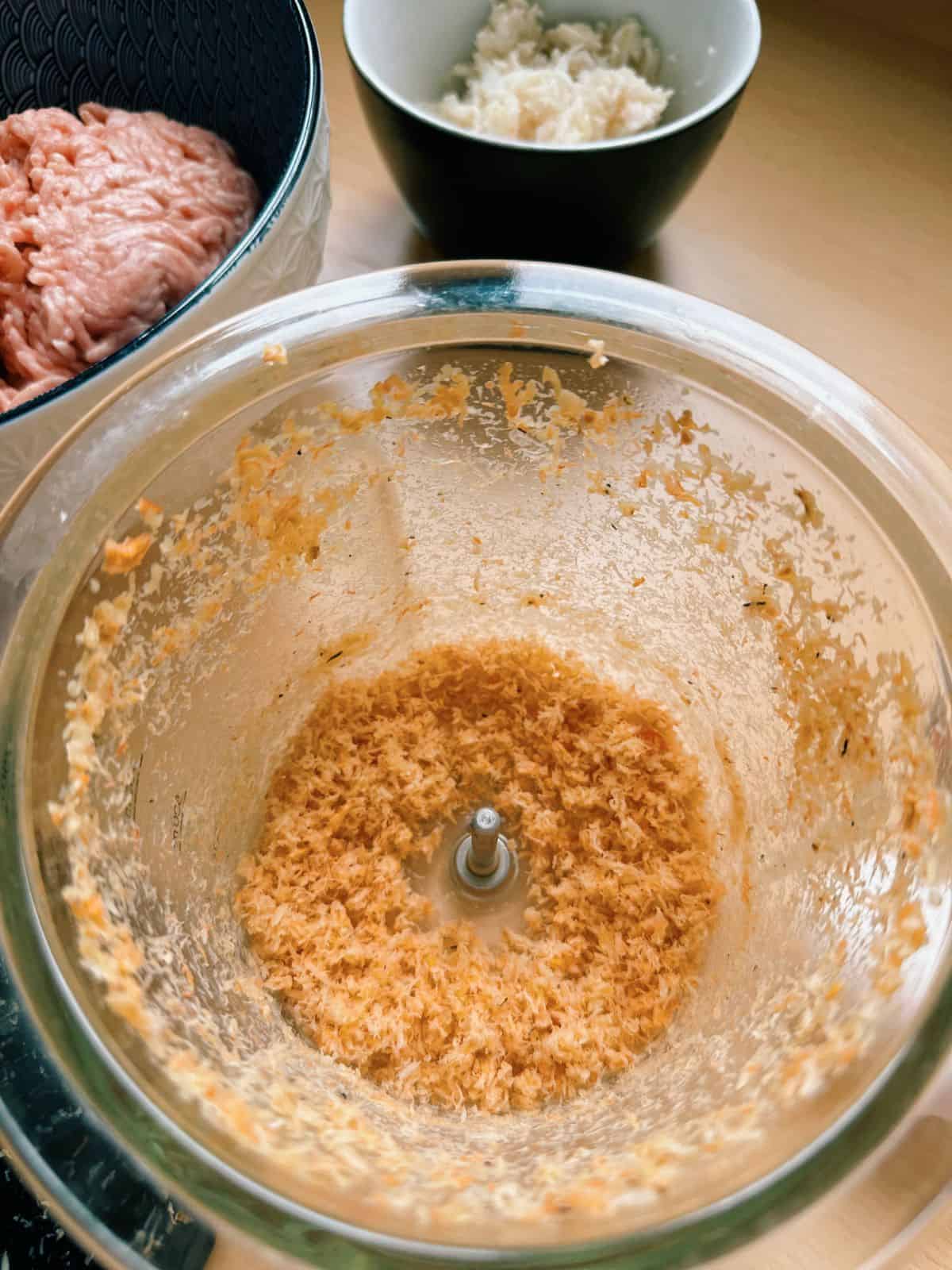
- In a bowl, mix together ground pork, dried shrimp, crab meat, crab paste, and eggs. Season the mixture with fish sauce and sugar. To check the flavor, you can microwave a small portion and taste it. If you’re not using it immediately, you can store it in the fridge.


- Use two spoons to scoop the crab paste and drop it into the broth, which is simmering over medium-low heat. Riêu cua is ready when it floats to the surface. Add the leftover tomato wedges to the broth.
- Season the broth with fish sauce and chicken powder. The broth should be slightly saltier than desired since it will dilute when served with noodles.
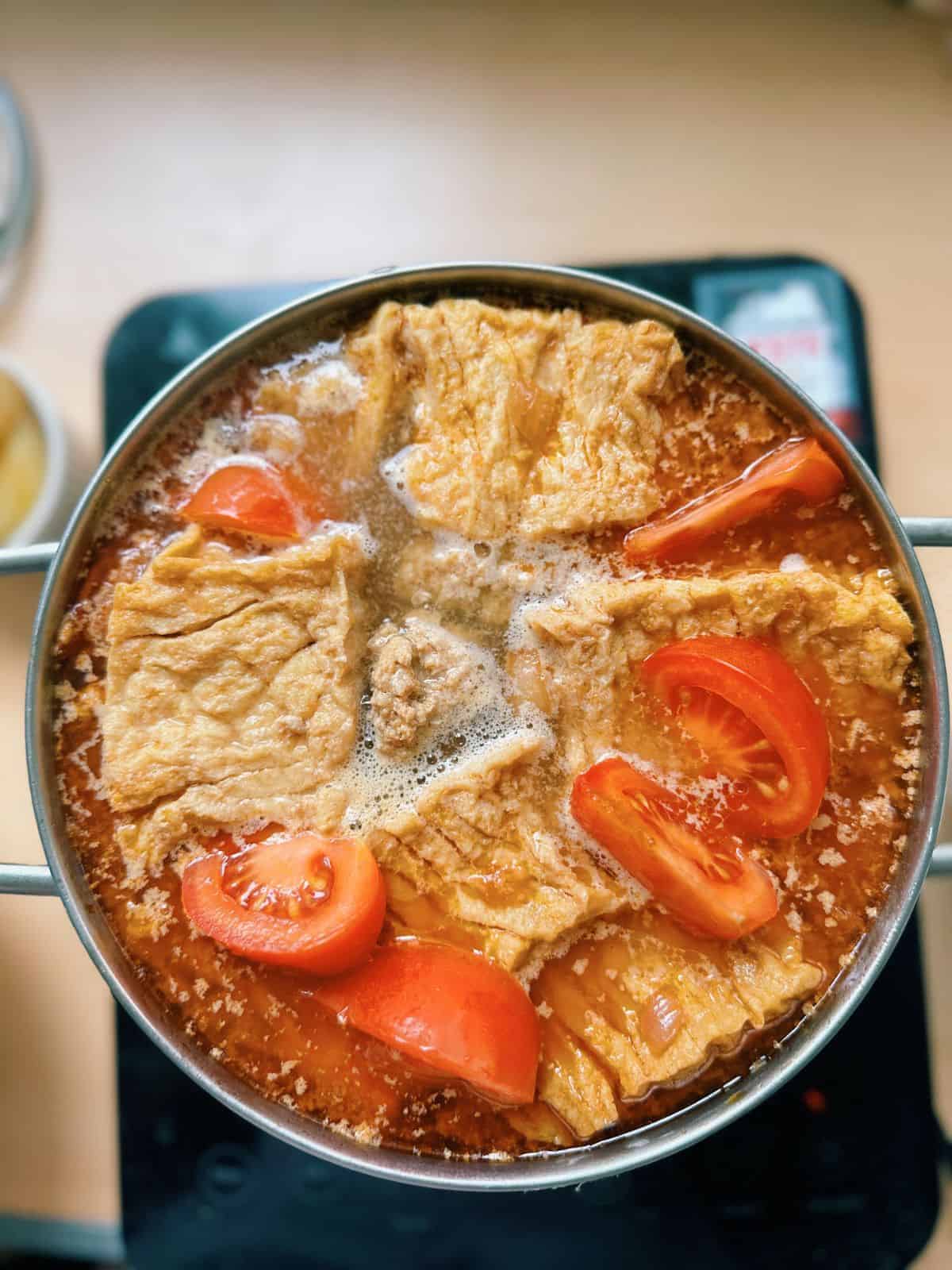
Cook rice noodles
- The thick rice noodles will take longer to cook than normal rice noodles (at least 30 minutes), which is why I recommend soaking them for at least 2 hours.
- Cook the rice noodles in COLD WATER otherwise your noodles could break easily. It’s important to taste the noodles every few minutes to check if they’re done.
- Rinse the noodles in cold water several times until the water runs clear. Drain the noodles well.
Blanch the water spinach (Ong Choy)
- Cut the water spinach into 8-inch pieces (20cm).
- Thoroughly wash the vegetables in water with couple of soaks and rinses.
- In another pot, add some salt to the water. Blanch the water spinach in boiling water for about 1 minute.

Assemble
- In serving bowls, arrange the rice noodles. Top with pork ribs, crab paste, tofu, water spinach, and tomato. Pour broth over the noodles. Garnish with green onions and cilantro.
- Season with mắm tôm and tamarind sauce (or lime) to your taste. Enjoy!
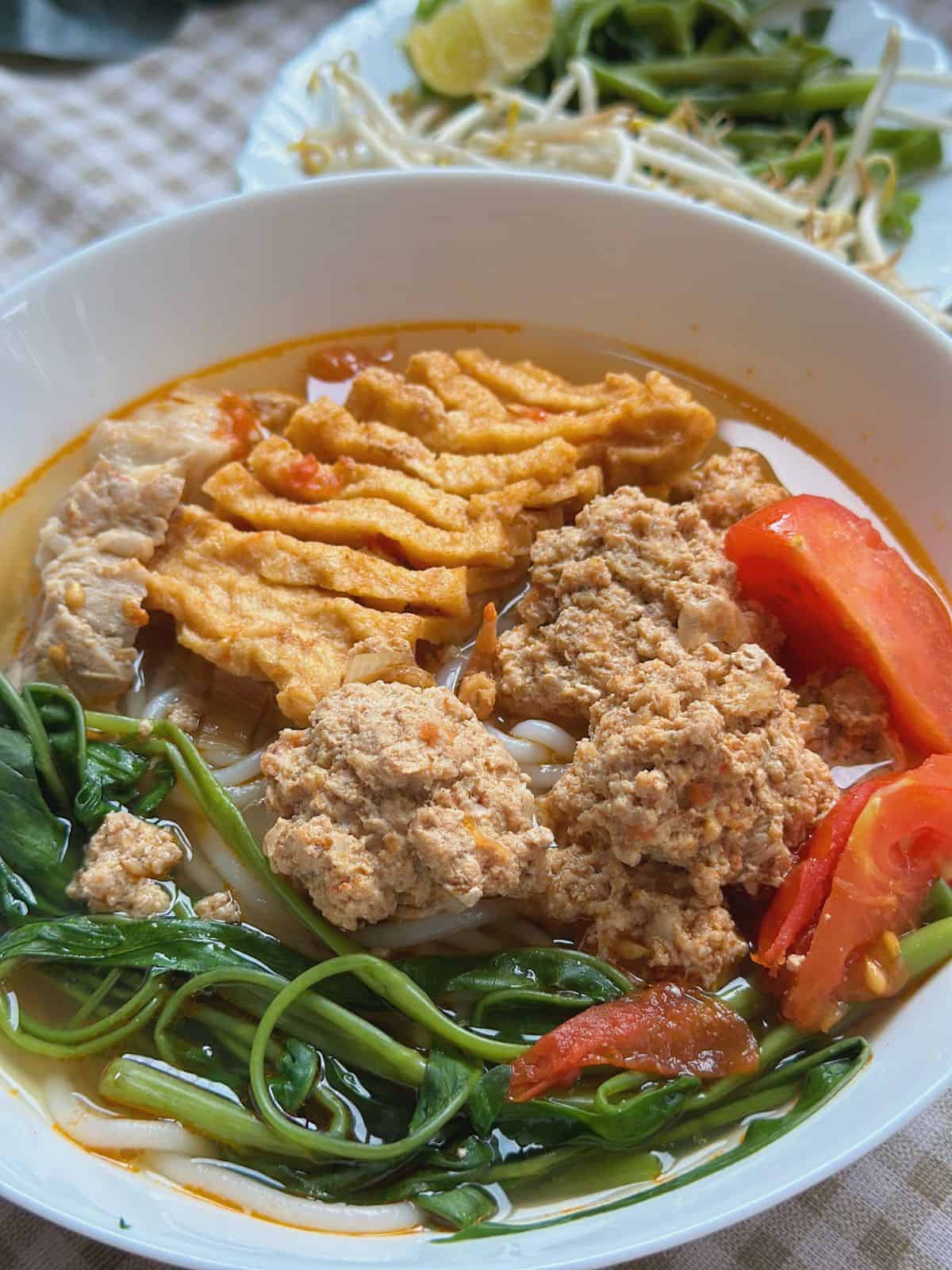
Helpful Tips
- Adjust the amount of eggs: use one egg if you prefer your riêu cua to have a meaty, meatball-like texture, or add one or two more eggs if you prefer a melt-in-the-mouth texture.
- You can use the leftover canned crab paste to prepare Vietnamese omelette (Trứng Chiên).
More authentic Vietnamese recipes





Canh Bún (Vietnamese Crab Noodle Soup with Water Spinach)
Ingredients
Broth
- 1 pound pork ribs (450g)
- ⅛ cup dried shrimps (30g)
- 1 bulb onion
- 1 stalk lemongrass (optional)
- 1 tbsp salt (to your taste)
- 1 tbsp rock sugar (15g) (granulated sugar is ok)
- 1 tbsp chicken powder (to your taste)
- 3 tbsp fish sauce (to your taste)
- 8.5 cup water (2 litesr)
- 3 tomatoes (cut into wedges)
- 1 bulb shallot (thinly sliced)
- 1 tbsp paprika powder
- 3 tbsp cooking oil
- Fried tofu
Crab Paste (Riêu Cua)
- 1 pound ground pork (450g)
- ⅛ cup dried shrimps
- 4.4 oz crab meat (125g) (optional)
- 4 tbsp canned crab paste (Bún Riêu Cua seasoning)
- 1-3 eggs
- fish sauce (to your taste)
- sugar (to your taste)
Other ingredients
- 1 package Bún Bò Huế Thick Rice Noodles
- 1 bunch Water Spinach (Ong Choy)
- Mắm Tôm (fermented shrimp paste)
- Tamarind sauce (optional)
- Lime/Lemon (cut into wedges)
- Green onion
- Cilantro
Instructions
Prepare the broth:
- Wash the dried shrimps.
- Parboil the pork ribs with some salt, then thoroughly wash and rinse them.
- Put the pork ribs back to the pot along with water, onion, lemongrass, dried shrimps, salt, and rock sugar. Simmer over medium-low heat for one hour, making sure to skim off any scum that rises to the surface.
- In a pan, heat some cooking oil and 1 tablespoon of paprika powder over medium-low heat for about 3 minutes to infuse the red color from the paprika powder into the oil.
- Add the sliced shallot and sauté until fragrant, then add 2/3 of the tomato wedges. Stir-fry the tomato with some fish sauce until they are soft and fully cooked.
- Transfer all the tomatoes to the broth. Don't forget to scrape all the tomato sauce from the pan—it's the golden liquid.
- Finally, add the fried tofu to the broth.
Prepare the crab paste (riêu cua):
- Rinse the dried shrimps and soak them in water until they become plump and soft. Drain the shrimps, and add the soaking water to the broth.
- Blend the shrimps in a food processor until they get a cotton floss-like texture.
- Mix ground pork, dried shrimp, crab meat, crab paste, and eggs in a bowl. Season the mixture with fish sauce and sugar. To taste, microwave a small portion and adjust seasoning as needed. If not using immediately, refrigerate.
- With two spoons, scoop the crab paste and gently drop it into the simmering broth over medium-low heat. Riêu cua is ready when it floats to the surface. Add the remaining tomato wedges to the broth.
- Season the broth with fish sauce and chicken powder. Keep in mind that the broth should have a slightly saltier flavor than desired as it will dilute when served with noodles.
Cook rice noodles:
- Thicker rice noodles require a longer cooking time than regular ones (at least 30 minutes), so I suggest soaking them for at least 2 hours beforehand.
- When cooking the rice noodles, ensure you use COLD WATER to prevent them from breaking easily. Remember to taste the noodles every few minutes to check their doneness.
- After cooking, rinse the noodles thoroughly in cold water several times until the water runs clear. Drain the noodles well before serving.
Blanch water spinach:
- Cut the water spinach into pieces that are 8 inches (20cm) long.
- Wash the vegetables in water with couple of soaks and rinses.
- In a pot, add salt to the water and blanch the water spinach in boiling water for about 1 minute.
Serve:
- In serving bowls, place the rice noodles, followed by pork ribs, crab paste, tofu, water spinach, and tomato. Pour the broth over the noodles. Garnish with green onions and cilantro.
- Adjust the flavor with mắm tôm and tamarind sauce (or lime) according to your preference. Enjoy!

